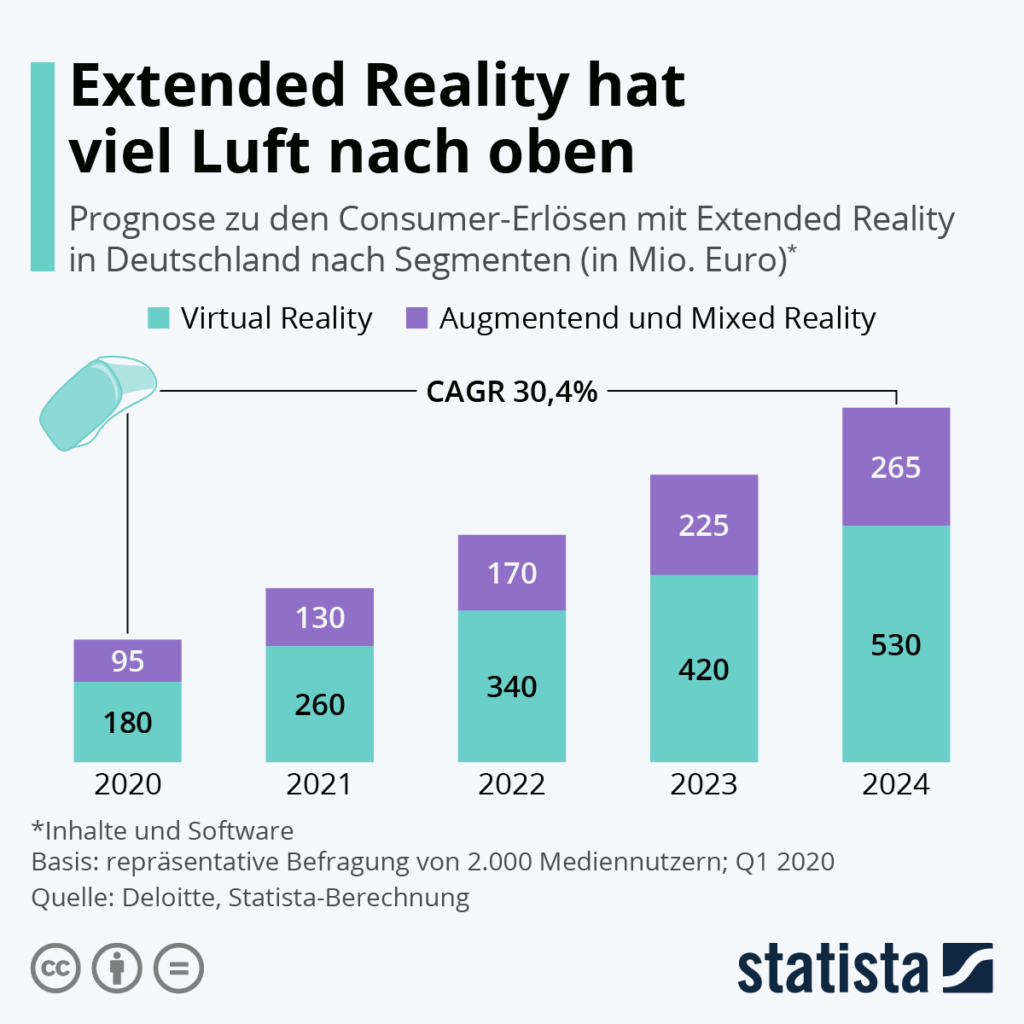Extended Reality with Facebook Metaverse
Language selection 📢
Published on: October 26, 2021 / update from: November 4, 2021 - Author: Konrad Wolfenstein
Facebook Metaverse
Facebook wants to play a key role in shaping the future of the extended reality market and is planning numerous new jobs in Europe. As the graphic below shows, consumer revenue from this promising technology could also increase significantly in the coming years - by around 30 percent per year. The forecast includes both content and hardware sales. Experts expect that extended reality could receive a boost, particularly in connection with the new and particularly fast 5G infrastructures. High bandwidths combined with short latency times could enable a range of data-intensive applications.
Extended Reality includes the three forms of technology: Virtual Reality (VR), Augmented Reality (AR) and Mixed Reality (MR). is a computer-created, virtual environment. The first mass-market application of virtual reality is in the area of video games. So-called virtual reality glasses (head-mounted displays) are intended to enable players to dive deeper into computer-animated game worlds. Augmented reality is defined as the projection of information and holograms in our immediate surroundings. Mixed reality is similar to augmented reality, but interaction between the real and the virtual is also possible.
Facebook founder and CEO Mark Zuckerberg announced back in July that Facebook would become a metaverse company in the next five years. The online event Facebook Connect (formerly Oculus Connect) will take place on October 28th and 29th and is a virtual online event that aims to help shape the future of augmented and virtual reality. At the keynote, Zuckerberg is expected to explain in more detail what he imagines the Metaverse to be and announce the first concrete steps in this direction. “We will explore what it takes to bring the Metaverse to life,” says the XR conference website.
Suitable for:
Metaverse - Metaverse
The word “metaverse” consists of the pre -iling “Meta” (beyond) and the word stem “verses” (a regression of “universe”); The term is usually used to describe the concept of a future iteration of the Internet, which consists of permanent, shared, virtual 3D rooms that are connected to a perceived virtual universe. The meta verse in the broader sense can not only refer to virtual worlds, but also to the Internet as a whole, including the entire spectrum of expanded reality.
In contrast, a massively multiplayer online role-playing game consists of a single world. In the Metaverse, users can help shape the worlds and “live, learn, work, celebrate” there.
The term metaverse was popularized by Neal Stephenson in his 1992 science fiction novel Snow Crash. In the epilogue he claims that he invented the term for this book as a marketing gimmick, just like "Avatar".
Since the 2020s, the metaverse has experienced a new hype through the sale of virtual land (Decentraland, The Sandbox). There are also projects such as NEOS VR and Dual Universe that aim to create huge worlds that will ultimately grow into a metaverse.
Tim Sweeny, the founder of the Fortnite studio Epic Games, had repeatedly confirmed that he wanted to work on a metaverse. In April 2021, Epic Games officially confirmed plans for a metaverse project.
In July 2021, Mark Zuckerberg announced that he wanted to convert Facebook into the metaverse.
Contributions from Matthew Ball have a particular influence on the debate about the Metaverse. His essay The Metaverse: What It Is, Where to Find it, Who Will Build It, and Fortnite[10] and articles based on it were written by Facebook boss Mark Zuckerberg declared compulsory reading for his employees.
Metaverse vs. Cyberspace and Nissan's 'Invisible to Visible' (I2V) technology
The term was coined in Neal Stephenson's 1992 science fiction novel Snow Crash, in which people interact with each other and with software agents as avatars in a three-dimensional virtual space that uses the metaphor of the real world. Stephenson used the term to describe a virtual reality-based successor to the Internet. Concepts similar to the Metaverse appeared in the cyberpunk genre under various names as early as 1981 in the novella True Names. Stephenson explained in the afterword to Snow Crash that after completing the novel, he learned of Habitat, an early MMORPG similar to the Metaverse.
The concept of cyberspace, which first appeared in the short story “Burning Chrome” by William Gibson (Omni, July 1982), was a central theme in his groundbreaking novel Neuromancer in 1984. The entirety of the common online space across all dimensions of the representation ”. In contrast to the fictional concept presented in neuromans, which was characterized by a Kartesian separation of body and mind, metavers enables its users access to its surroundings while they are still aware of their world. This is demonstrated in a technology called Invisible to Visible (I2V) developed by Nissan, which overlaps the windshield of a car with virtual information and, among other things, offers the opportunity to bring a 3D avatar into the vehicle.
Massively Multiplayer Online Game
Because many massively multiplayer online games have similar features to the Metaverse but only provide access to non-persistent instances shared by up to several dozen players, the concept of virtual multiverse games has been used to distinguish them from the Metaverse .
Elements of the metaverse and its further development
The elements of the meta verse include “video conferences, games such as Minecraft or Roblox, cryptocurrencies, email, virtual reality, social media and live streaming”. The Cyberspace above has constantly developed and encompasses various computer -mediated virtual environments. Such an expanding cyberspace indicates a digital “Big Bang”, which is powered by various technologies and ecosystems. Technologies such as the extended reality, user interaction (human-computer interaction), artificial intelligence, blockchain, computer vision, edge and cloud computing and future mobile phone networks enable the current Internet to the meta verse. The Meta-Verse ecosystem enables human users to live and play in a self-preserved, permanent and common world. Therefore, the Metaverse ecosystem takes into account user-centered elements such as avatar, content creation, virtual economy, social acceptance, security and data protection as well as trust and responsibility.
Virtual world timeline
Notable platforms and developments:
- 1993 - The Metaverse was a MOO (a text-based, low-bandwidth virtual reality system) operated by Steve Jackson Games as part of their BBS, Illuminati Online.
- 1995 - Active Worlds, based entirely on Snow Crash, sells virtual reality worlds that at least implement the concept of the Metaverse.
- 1998 – There.com is founded, in which users act as avatars and can socialize and purchase items and services using the virtual currency Therebucks, which can be purchased with real-world money. There.com closed on March 2, 2010, but reemerged in 2011 as an invite-only world for users aged 18 and over.
- 1998 – blaxxun created 3D virtual communities using vrml technology. CyberTown was an example of this.
- 2003 – Second Life was launched by Linden Lab. The project's stated goal was to create a custom world like the Metaverse where people could interact, play, transact, and otherwise communicate.
- 2004 - X3D is recognized by ISO as the successor to the Virtual Reality Modeling Language (VRML) as an open standard for interactive real-time 3D (web3D). Today, X3D is the standard that defines the open metaverse for 3D web and mixed reality by connecting virtual, mirrored and augmented realities to the web.
- 2004 – IMVU, Inc. is founded by Will Harvey, Matt Danzig and Eric Ries. It started as an instant messenger with 3D avatars.
- 2005 - The University of Michigan starts in response to the decision of the Supreme Court of the United States as a fundamental judgment on positive discrimination (Grutter v. Bollinger and Gratz v. Bollinger) in order to make their campus more accessible from minorities from minorities. Vmerse was described as a revolutionary innovation to increase diversity on campus. This metaverse was provided on computers on the Internet as a combination of video, forms, embedded in a mirror world by virtual reality, and was also used for alumni relationships, donor campaigns and for emergency training. Vmerse technology was also used by the Louisiana State University, Iowa State University, Columbia University, Stanford University, Western Illinois University and others. The United States Ministry of Foreign Affairs used Vmerse as “Your 5 Steps to Us Study” to support international students in applying to US universities and was used by over 1 billion users around the world. Vmerse was founded and invented by Bhargav Sri Prakash in 2004 and is now the proprietary platform, which was adapted by Friendslearn for use in medicine.
- 2005 – Solipsis is launched, a free, open source system intended to provide the infrastructure for a Metaverse-like public virtual realm.
- 2005-The Croquet project was started as an open source software development environment for the “creation and provision of online applications for the cooperation of several users on various operating systems and devices” with the aim of being less proprietary than second life. After the Croquet SDK was published in 2007, the project was converted into the Open Cobalt project.
- 2006 – Entropia Universe, the world's first MMORPG with a real money economy.
- 2006 – Roblox is released.
- 2007 – Several social networks provide profiles and networking opportunities for Metaverse Avatars, including Koinup, Myrl, AvatarsUnited. These projects faced many challenges related to the lack of portability of the avatar to other virtual worlds and attempted to address the possibility of managing multiple accounts from a single dashboard. (AvatarsUnited was later acquired by Linden Lab and then discontinued when some social networking features were added to Second Life).
- 2007 – OpenSimulator appears, developing free, open-source virtual world software that is protocol compatible with Second Life while allowing user movement between otherwise independent installations. It is based on Second Life's client viewer and serves as a platform for building a virtual world.
- 2008 – Google Lively was introduced by Google through Google Labs on July 8, 2008. The service was suspended at the end of December.
- 2013-The K-Pop girls group Girls' Generation organizes one of the first virtual concerts in which the life-sized holograms of the members are projected onto a stage.
- 2013 - High Fidelity Inc. is founded as an open source platform where users can create and deploy virtual worlds, explore and interact together.
- 2014 – VRChat launches as a social VR platform (SVRP), allowing users to publish 3D rooms and avatars developed using external tools.
- 2015 – Launch of AltspaceVR as SVRP, allowing users to publish 3D spaces developed using external tools.
- 2016 – Sinespace launched as SVRP, allowing users to publish 3D spaces and content developed using external tools. Rec Room launched as a social VR game that expanded to support user-generated rooms in 2017. Anyland and Modbox launched as social VR games that allow users to publish 3D spaces developed using built-in tools.
- 2017 – Sansar launched on July 31, 2017. The platform enables user-created 3D spaces as social spaces. The avatars include voice-controlled facial animations and motion-controlled body animations.
- 2018 – NeosVR Metaverse was launched by Solirax. Cryptovoxels launched in 2018 as a user-owned metaverse using the Ethereum blockchain.
- 2019 – Facebook Horizon was announced as Facebook's social VR world.
- 2020 – Decentraland launches as a decentralized virtual platform owned and operated by its users. The Sandbox, a voxel metaverse, is launched by Animoca. Core is created by Manticore Games.
- 2020 - Rival Peak, a cloud-powered reality show featuring AI contestants in a virtual environment, debuts on Facebook Watch. Individuals or groups of viewers could directly contribute to an AI contestant's advancement on the show by watching or interacting via Facebook.
- 2020 – Beyond Live, an online concert platform, is launched.
- 2020 – SM Entertainment, a KPop agency, collaborates with one of their groups, aespa, to create a virtual universe called SM Culture Universe as a platform for their artists.
- 2021 - Epic Games initiates fundraising to expand Fortnite into a metaverse.
- 2021 - Microsoft Mesh, a mixed reality software that enables virtual presence via Microsoft devices such as the HoloLens 2.
- 2021 – South Korea announces the formation of a national Metaverse alliance with the aim of building a unified national VR and AR platform.
Metaverse Science Fiction: The Matrix
The Matrix is a film series depicting a dystopian future in which humanity is unknowingly trapped in a metaverse called the Matrix, created by intelligent machines to distract humans and use their bodies as a source of energy.
Xpert.Digital – Konrad Wolfenstein
Xpert.Digital is a hub for industry with a focus on digitalization, mechanical engineering, logistics/intralogistics and photovoltaics.
With our 360° business development solution, we support well-known companies from new business to after sales.
Market intelligence, smarketing, marketing automation, content development, PR, mail campaigns, personalized social media and lead nurturing are part of our digital tools.
You can find out more at: www.xpert.digital – www.xpert.solar – www.xpert.plus































